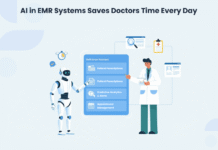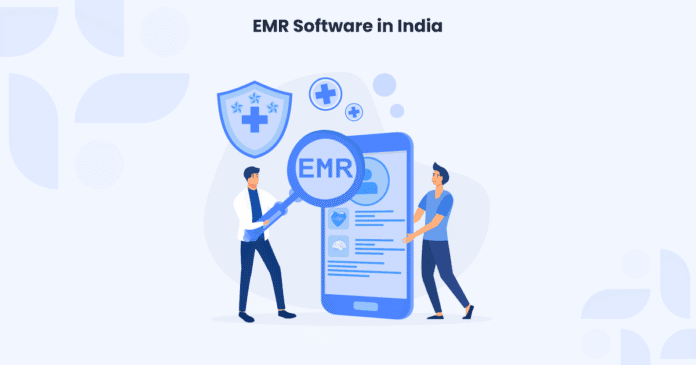
Healthcare in India is at a turning point. For decades, clinics and hospitals have depended on paper records, handwritten notes, thick files, and prescriptions scribbled in a hurry. But paper has its limits. Files go missing. Handwriting causes mistakes. And patients often carry bits of their medical history scattered across different places.
This is where Electronic Medical Records (EMR) software comes in. It brings all of that information into one secure, digital system.
If you’re a doctor or clinic owner, you might be wondering: What exactly is EMR? How does it work in India? And is it worth investing in?
That’s what this guide is about. Let’s break it down step by step.
What is EMR Software?
An EMR (Electronic Medical Record) is simply a digital version of a patient’s paper file.
Instead of manually writing patient history, prescriptions, and lab reports, everything is stored digitally and can be retrieved with a few clicks.
An EMR usually includes:
- Patient details
- Medical history and ongoing conditions
- Doctor’s notes and prescriptions
- Lab reports and scans
- Follow-up reminders and treatment plans
Think of it as the clinic’s digital memory, organized, searchable, and secure.
EMR vs EHR: What’s the Difference?
Many people confuse EMR and EHR, but there’s a difference.
- EMR : Digital records that usually stay within a single clinic or hospital.
- EHR : A broader system that allows sharing of records across multiple providers doctors, hospitals, labs, and pharmacies.
Most small clinics in India start with EMR because it’s simpler and affordable. But with government initiatives like the Ayushman Bharat Digital Mission (ABDM), the country is slowly moving toward EHRs where patient records can be accessed anywhere.
Why EMR Matters for Indian Clinics
Paper records may seem easy, but they create everyday headaches lost files, handwriting errors, and difficulty in follow-ups.
Key Benefits for Clinics and Patients:
- Faster record access
- Fewer mistakes in prescriptions
- Better patient tracking
- Easy long-term history management
- Improved trust and patient satisfaction
An EMR solves these problems. For clinics, it means faster work and fewer mistakes. For patients, it means better care and more trust in their doctor.
Benefits of EMR for Small Clinics
Small clinics often assume digital systems are only for hospitals. But actually, smaller practices gain the most.
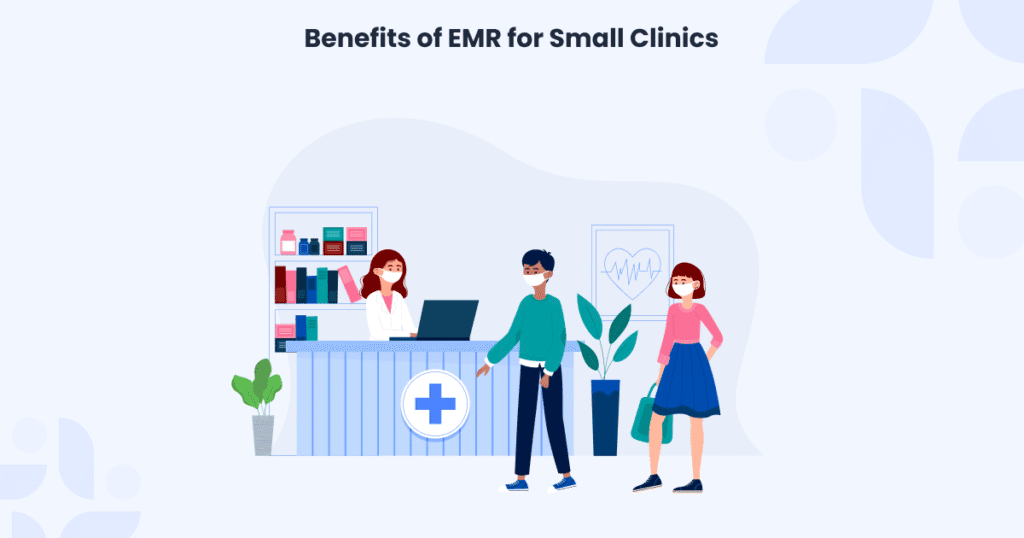
Some key benefits:
- Saves consultation time
- Sends appointment or medicine reminders
- Builds patient loyalty
- Reduces staff workload
- Enhances the clinic’s professional image
With Healcard, even a small clinic can digitize operations without heavy costs or IT support.
NHA & ABHA-Compliant EMRs in India
The National Health Authority (NHA) has introduced the Ayushman Bharat Digital Mission (ABDM) to create a connected healthcare system.
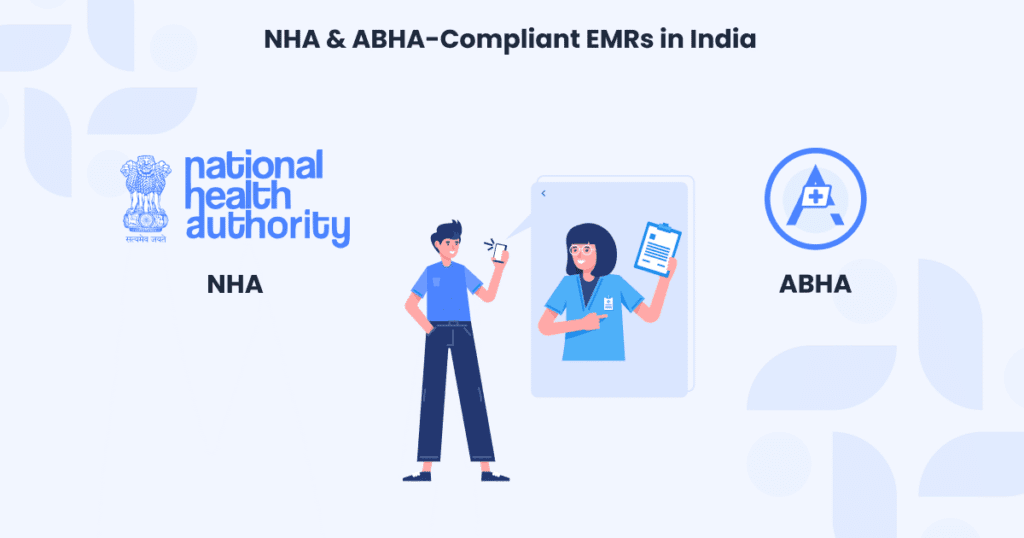
A major part of this is the ABHA (Ayushman Bharat Health Account) ID. It’s a unique health ID for every citizen. Clinics using ABHA-compliant EMRs can link patient records to these IDs, making them portable across hospitals and states.
For doctors, this means easier access to medical history. For patients, it means continuity of care no matter where they go.
Healcard’s EMR software is fully ABHA-ready, helping clinics stay compliant while serving patients better.
Cost of EMR Software in India
Pricing depends on features and clinic size. Here’s a rough idea:
- Basic EMR (₹500–₹1,000/month): Good for solo doctors.
- Mid-range EMR (₹1,000–₹3,000/month): Includes billing, ABHA, and reminders.
- Advanced EMR (₹5,000+/month): For multi-specialty clinics/hospitals.
Don’t choose only on price ease of use and support matter more than flashy features.
Challenges in Adopting EMR
Switching from paper to digital isn’t always smooth. Common hurdles include:
- Staff resistance: Some may feel it’s “too complicated.”
- Data migration: Moving old records takes time.
- Internet issues: Not all areas have stable connections.
- Initial learning curve: It feels slower in the first few weeks.
The good news? These problems don’t last. Once staff see how much time EMRs save, adoption becomes easier.
How to Choose the Right EMR in India
There are many options in the market, which makes choosing tricky. Here’s what to check:
- Is it ABHA/NHA compliant?
- Can my staff use it without heavy training?
- Does it fit my budget?
- Does it include essentials like prescriptions, billing, and reminders?
- Can I use it on both mobile and computer?
- Is customer support available when I need it?
Healcard ticks all these boxes it’s simple, affordable, and designed for Indian clinics.
Security & Data Privacy
With sensitive health data going digital, security is a top concern. A good EMR should:
- Encrypt data
- Use role-based access (doctor vs staff)
- Store backups securely in the cloud
- Follow India’s data hosting/localization rules
This builds both compliance and patient trust.
The Future of EMR in India
India’s digital healthcare ecosystem is growing fast. Here’s what’s coming:
- AI-enabled EMR software in India suggests diagnoses or treatments.
- Telemedicine integration so video consultations sync with records.
- Wearable devices like fitness bands and glucometers are linking directly to EMRs.
- Interoperability, where a patient’s record can be accessed anywhere in the country.
Clinics adopting EMRs today will be future-ready tomorrow.
Quick Look Back: How EMRs Came to India
If you’re wondering how EMRs even started here, let me give you a quick picture.
At first, only big hospitals in metro cities used EMRs because they had the budgets and IT teams. Smaller clinics stuck to paper because it felt cheaper and simpler. But over the last 8–10 years, two things changed:
- Technology got cheaper. Cloud-based software meant you didn’t need servers or heavy setups.
- The government stepped in. With the Ayushman Bharat Digital Mission (ABDM) and ABHA health IDs, there’s now a clear push to digitize healthcare across India.
Today, Healcard EMR software makes it possible for even a two-room clinic to go digital.
Paper Records vs EMRs: A Simple Comparison
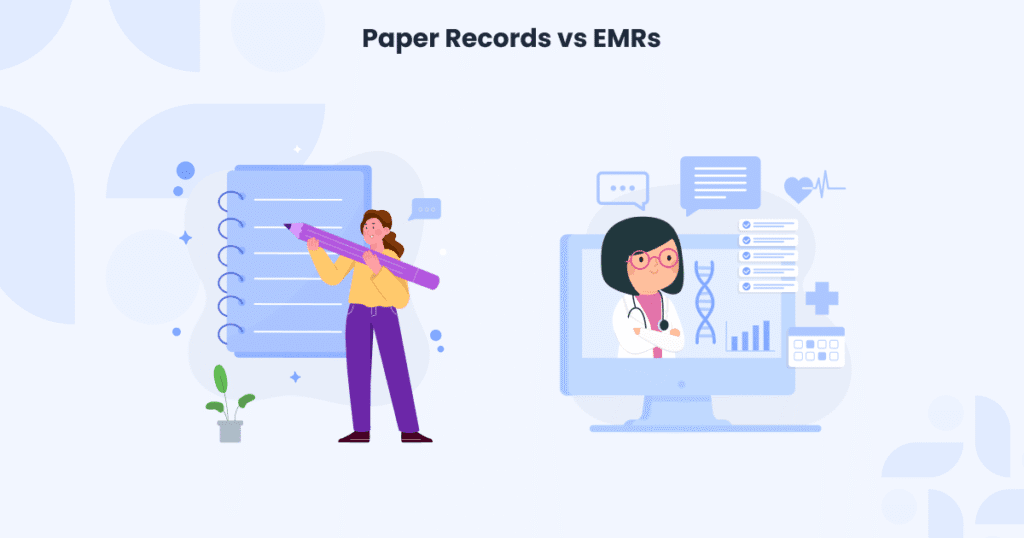
| Feature | Paper Records | EMR Software |
| Storage: | Bulky files, hard to manage | Stored digitally,cloud-based |
| Access: | Only inside the clinic | Anywhere, anytime |
| Errors: | Handwriting issues, misplaced notes | Clear, auto-generated |
| Cost (long-term): | Printing, filing, extra staff | Lower after setup |
| Patient Experience: | Outdated | Modern and professional |
This is why I say paper belongs in the past.
Mobile EMRs vs Desktop EMRs
| Aspect | Desktop EMR | Mobile EMR |
| Where You Use It | Only on your clinic computer | On your phone or tablet, anywhere |
| Best For | In-depth work like reports, billing, long patient histories | Quick checkups, daily patient care, remote access |
| Speed | Fast, handles large data easily | Depends on internet, may be slightly slower with big data |
| Accessibility | You must be at the clinic | Always available on the go |
| Updates | Need to update manually | Updates automatically via the cloud |
| Convenience | Less flexible | Highly flexible, works anywhere |
| Data Sharing | Usually local unless synced | Syncs automatically with desktop/cloud EMR |
In short: Desktop EMRs are like your office “engine room” strong, fast, and great for heavy tasks. Mobile EMRs are your portable toolkit handy, flexible, and perfect when you’re on the move. Most clinics now use both together so nothing slows them down.
Top Features to Look for in EMR Software
Not all EMR software works the same way. When choosing one for your clinic, focus on these must-have features:
- Patient Records: Store everything in one place medical history, prescriptions, lab results, scans so you can find it easily.
- Appointment Management: Schedule patients, send reminders, and cut down on missed appointments.
- Billing & Invoicing: Keep billing simple and accurate with built-in invoicing. No more manual errors.
- Mobile Access: Check patient records or update notes from your phone or tablet, even on the go.
- ABHA/ABDM Compliance: In India, this ensures your EMR links with national health IDs, keeping records standardized.
- Data Security: Protect patient info with encryption, backups, and restricted access.
- Analytics & Reports: Track how your clinic is doing patient trends, revenue, and other key stats.
- Integration with Labs & Pharmacies: Makes ordering tests and sending prescriptions smooth and hassle-free.
Choosing EMR software with these features makes your clinic run faster, smarter, and ready for the future.
Common Misconceptions About EMR
Many doctors avoid EMRs because of some common myths. Let’s set them straight:
EMR is only for big hospitals.
Not true. Even small clinics get huge benefits less paperwork, fewer mistakes, and smoother patient care.
It’s too expensive.
Not really. Cloud EMRs have affordable monthly plans, often cheaper than hiring extra staff just to manage paper files.
It’s too complicated for my staff.
Most modern EMRs are simple to use. Staff usually pick it up in a few hours.
It will slow down my practice.
There’s a brief adjustment period, but once your team gets used to it, EMRs actually make work faster.
Paper records are enough.
Paper works, but it’s easy to misplace or mess up. EMRs keep your clinic organized, efficient, and build patient trust.
FAQs About EMRs in India
Here are some of the common questions I get about EMRs, answered in plain language:
No, it’s not compulsory right now. But with ABHA IDs and the Ayushman Bharat Digital Mission rolling out, it’s clear the government wants every clinic to move in that direction. If you start early, you’ll be ahead of the curve.
Yes, most modern EMRs are cloud-based, which means you can log in from your phone, tablet, or computer. Super handy if you want to check records outside the clinic.
Not exactly. EMR manages medical records, while practice management includes billing and admin tasks. In India, many providers (like Healcard) bundle both together.
No, patients don’t pay anything for their ABHA health ID. The cost of using ABHA-ready software is on the doctor or clinic side.
The “best” EMR depends on your needs budget, staff comfort, and features. The best EMR software in India is the one that fits smoothly into your workflow like Healcard.
Effective EMRs utilize encryption, secure cloud servers, and robust login access controls. Always pick software that follows India’s data protection rules. It keeps both you and your patients safe.
You don’t need to scan every old file right away. Most clinics start fresh with new patients in the EMR and slowly add older records as needed. For older files that aren’t very important, you can just keep them safely stored. The goal is to move everything online over time, not run both paper and digital systems forever.
Some can. A few EMRs let you work offline and sync data later when you’re online. Handy if your clinic’s Internet isn’t always reliable.
Not really. A basic computer or tablet with Internet is enough. If it’s cloud-based, you don’t need servers or IT setups.
Yes, once you get used to it. You’ll spend less time hunting for files, make fewer mistakes, and handle more patients smoothly.
Some EMRs offer Hindi and other local language support. If your patients prefer local language prescriptions, look for that feature before you buy.
Conclusion
Paper files had their time, but they can’t keep up with today’s healthcare needs. EMRs bring everything into one secure plac faster, safer, and easier for both doctors and patients.
Yes, the switch takes a little effort in the beginning, but it pays off quickly with smoother work and better care. And with India moving toward digital health and ABHA IDs, adopting Healcard EMR software now means your clinic is ready for the future.



